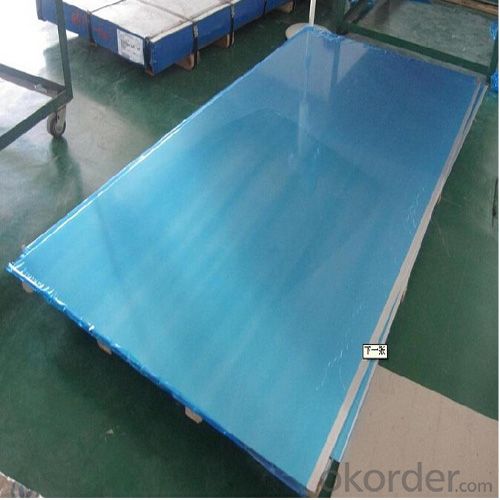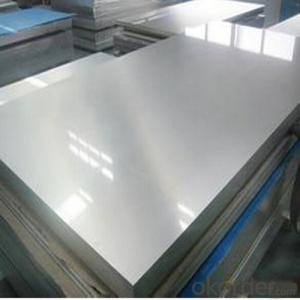Hot Rolling Thick Aluminum Sheet with High Quality
- Loading Port:
- Shanghai
- Payment Terms:
- TT OR LC
- Min Order Qty:
- 5 m.t
- Supply Capability:
- 10000 m.t/month
OKorder Service Pledge
OKorder Financial Service
You Might Also Like
Item specifice
1.Structure of Hot Rolling Thick Aluminum Sheet Description:
Hot Rolling Thick Aluminum Sheets are widely used for building use, decoration use, making cookware, busing making, shipping building, airplane making and so on。Sizes of aluminum sheet for decoration use: Thickness: 0.3mm~300mm Width: Under 2000mm ( Standard: 1000mm, 1219mm, 1500mm, 1540mm) Length: Under 10000mm. Products commonly used in signs, billboards, building exterior decoration, bus body, high factory wall decoration, kitchen sink, lamp, fan, electronic components, chemical apparatus, sheet processing, deep drawing or spinning hollow ware, welding parts, heat exchangers, Bell surface and plate, plates, kitchen utensils, accessories, safety equipment and other.
2.Main Features of Hot Rolling Thick Aluminum Sheet:
Good mechanical properties.
Easy processing, wearability.
Corrosion resistance
Resistance to oxidation.
3. Hot Rolling Thick Aluminum Sheet Images:



4. Hot Rolling Thick Aluminum Sheet Specification:
| Aluminium sheet | |||||
| Alloy No. | Thickness (mm) | Width (mm) | Length (mm) | Temper | |
| A1050,A1060, A1070,A1100 | 0.2-100 | 20-2200 | 20-8000 | O,H12,H22,H14,H16,H18, H24,H26,etc | |
| 3A21,A3003,A3105,A3004 | 0.2-100 | 20-2200 | 20-8000 | O,H14,H18,H24,etc | |
| A5052 ,A5005,A5083,A5754 | 0.2-100 | 20-2200 | 20-8000 | O,H18,H24,H32,H34,H111,H112 ,etc | |
| A6061,A6082,A6063 | 0.2-200 | 20-2200 | 20-8000 | T4,T6, T651,etc | |
| A8011 | 0.2-100 | 20-2200 | 20-8000 | O,H12,H22,H14,H16,H18,H24,H26, etc | |
5.FAQ
Q1.How long have you been in this product?
A1:More than 10 years.
Q2. What's the minium quantity(MOQ)?
A2. 5 Metric tons
Q3. How long is shipping time?
A3. 7 (ready-made products)-25 days(OEM)
Q4. How do you guarantee the quality?
A4. 1. Cooperating and Exchaning experience with sevral quoted aluminum companies
2. Japanese and Swiss production line and skilled works (regular training and testing)
3. more than 10 years production experience.
Q5. Do you have after sale service?
A5. Yes. Any quality problem occurs within one year, pls take photoes,we will be responsible.
- Q:Can aluminum sheets be used in marine environments?
- Yes, aluminum sheets can be used in marine environments. Aluminum is a commonly used material in marine applications due to its excellent corrosion resistance. It forms a protective oxide layer on its surface, which prevents further corrosion in the presence of saltwater or other corrosive elements found in marine environments. Aluminum sheets are lightweight, yet strong, making them ideal for a variety of marine structures such as boat hulls, decks, and superstructures. Additionally, aluminum is highly durable and has a long lifespan, further enhancing its suitability for marine applications.
- Q:Can aluminum sheets be used for solar panels?
- Yes, aluminum sheets can be used for solar panels. Aluminum is a commonly used material in the construction of solar panels due to its lightweight, durability, and excellent heat dissipation properties. The use of aluminum helps to reduce the overall weight of the solar panels, making them easier to install and transport. Additionally, aluminum is highly resistant to corrosion, ensuring the longevity of the solar panels even in harsh weather conditions.
- Q:Hi, I'm new here. Yoroshigu.I'm trying to make flash paper for magic tricks.To do that I have to make flash powder but in my location I can hardly find ingredients. Not to think about buying. Usually, I wait for a season and buy firecrackers. Then, I take the power and soak them into the paper and dry. This works but not so flash. Burned more likely.So, I wonder if I take aluminium oxide from aluminium oxide sandpaper and mix with powder from firecracker would produce a brighter flash than firecracker power alone?anyone know please share.
- Aluminum oxide is a ceramic. Ceramics are already, in their lowest energy state and won't give you the effect you're looking for: The sand (that's all aluminum oxide is) that you're adding will make your flash dimmer (and dirtier). You want to get some aluminum metal powder. It is very reactive, and will make your flash appear much brighter. You're on your own as far as the safety of this.
- Q:What are the common surface treatments for aluminum sheets used in outdoor applications?
- The common surface treatments for aluminum sheets used in outdoor applications include anodizing, powder coating, and PVDF coating.
- Q:are there any carbonated mineral water that are produced in aluminium cans.
- Aluminium cans have an oxide covering on them so the reaction between them and the carbonated water is so little if any that it can't be noticed. Aluminium is also not so high on the reactivity series
- Q:How do you join two aluminum sheets together?
- There are several methods to join two aluminum sheets together. One common technique is using mechanical fasteners such as screws, rivets, or bolts. These fasteners can be drilled or punched through the sheets, creating a secure connection. Another method is using adhesives specifically designed for aluminum bonding. These adhesives provide a strong and durable bond between the two sheets. Welding is another popular option, where the aluminum sheets are melted and fused together using heat. This method requires specialized equipment and expertise. Lastly, a technique called clinching can be used, which involves applying pressure to deform the aluminum sheets and interlock them together. Each method has its own advantages and considerations, depending on the specific application and desired outcome.
- Q:combines with oxygen with an atomic weight of 16, to form the compound aluminum oxide, how much oxygen would be required to react completely with 54g of aluminum?
- Well, Al2O3 is the formula for aluminum oxide So you have 2 moles of Al, so you need 3 moles of O which is 1.5 moles of O2 So the answer is 48g
- Q:6061-T6 can aluminum sheets be bent?
- You ask if the two batch of aluminum material has been aging, the hardness of the aluminum after aging is higher than before the aging. Another aluminum material from the extrusion after the storage time and environment also related. You can measure the hardness of the two batch of aluminum.
- Q:Are aluminum sheets suitable for use in HVAC (heating, ventilation, and air conditioning) systems?
- Aluminum sheets are indeed a fitting choice for HVAC systems. The popularity of aluminum in HVAC systems stems from its numerous advantageous properties. To begin, aluminum is both lightweight and robust, making it effortless to handle and install in HVAC systems. Its low density also enables cost-effective transportation and reduces the overall weight of the HVAC units. Furthermore, aluminum possesses exceptional resistance to corrosion. Given that HVAC systems often encounter moisture and condensation, particularly in air conditioning units, aluminum's corrosion resistance ensures its durability and longevity in such environments. Moreover, aluminum sheets exhibit commendable thermal conductivity, facilitating efficient heat transfer throughout the HVAC system. This property holds particular significance in heating and cooling applications, as it aids in effectively distributing the desired temperature. In addition, aluminum is a non-toxic material, rendering it safe for use in HVAC systems that circulate air within buildings. It does not emit any harmful particles or gases, thereby ensuring the quality of indoor air. Lastly, aluminum is highly recyclable, contributing to its environmental friendliness. The ability to recycle aluminum sheets reduces the carbon footprint associated with HVAC systems and aligns with sustainability objectives. Taking all these advantages into account, aluminum sheets undeniably prove suitable for use in HVAC systems. They offer an optimal combination of strength, corrosion resistance, thermal conductivity, safety, and environmental friendliness.
- Q:How do you prevent distortion of aluminum sheets during welding?
- To prevent distortion of aluminum sheets during welding, there are several key measures that can be taken: 1. Proper joint preparation: Ensuring that the edges of the aluminum sheets are properly cleaned and beveled before welding is crucial. This helps in achieving a better fit-up and minimizes the chances of distortion. 2. Fixture and clamping: Using appropriate fixtures and clamps to hold the aluminum sheets in place during welding can help to restrain and distribute the heat more evenly. This helps in reducing the risk of distortion by preventing the sheets from moving or buckling due to thermal expansion. 3. Tack welding: Prior to performing a full weld, tack welding can be done at regular intervals along the joint. This helps in temporarily fixing the sheets in place and distributing the heat, allowing for more controlled cooling and minimizing distortion. 4. Welding sequence: Applying a proper welding sequence can also help in preventing distortion. It is recommended to start welding from the center and gradually move towards the edges, alternating between sides. This helps in balancing the heat input and minimizing distortion by allowing the welded sections to cool down before the next weld is performed. 5. Preheating and post-weld heat treatment: For thicker aluminum sheets, preheating the material before welding can help to reduce the temperature gradient and minimize distortion. Additionally, post-weld heat treatment can be applied to relieve residual stresses and promote dimensional stability. 6. Welding technique: Employing appropriate welding techniques such as using a lower heat input and slower travel speed can help in minimizing distortion. Additionally, using a smaller weld bead size and avoiding excessive weaving can also help to control the heat input and reduce the chances of distortion. 7. Proper weld parameters: Ensuring that the welding parameters such as voltage, current, and wire feed speed are properly set and maintained is crucial. Using the correct parameters for the specific aluminum alloy being welded can help to achieve a more controlled heat input, minimizing distortion. By implementing these preventive measures, the risk of distortion during aluminum sheet welding can be significantly reduced, resulting in improved weld quality and dimensional stability.
1. Manufacturer Overview |
|
|---|---|
| Location | |
| Year Established | |
| Annual Output Value | |
| Main Markets | |
| Company Certifications | |
2. Manufacturer Certificates |
|
|---|---|
| a) Certification Name | |
| Range | |
| Reference | |
| Validity Period | |
3. Manufacturer Capability |
|
|---|---|
| a)Trade Capacity | |
| Nearest Port | |
| Export Percentage | |
| No.of Employees in Trade Department | |
| Language Spoken: | |
| b)Factory Information | |
| Factory Size: | |
| No. of Production Lines | |
| Contract Manufacturing | |
| Product Price Range | |
Send your message to us
Hot Rolling Thick Aluminum Sheet with High Quality
- Loading Port:
- Shanghai
- Payment Terms:
- TT OR LC
- Min Order Qty:
- 5 m.t
- Supply Capability:
- 10000 m.t/month
OKorder Service Pledge
OKorder Financial Service
Similar products
New products
Hot products
Related keywords




























